Laws20058 – Australian Commercial Law
VerifiedAdded on 2023/06/07
|12
|3214
|132
AI Summary
This article discusses Australian Commercial Law, criminal penalties, fraudulent misrepresentation, and contractual promises. It covers the rules, application, and remedies for each topic. The article also mentions subject, course code, and college/university.
Contribute Materials
Your contribution can guide someone’s learning journey. Share your
documents today.

Running head: LAWS20058 – AUSTRALIAN COMMERCIAL LAW 1
Laws20058 – Australian Commercial Law
Name
Institution
Laws20058 – Australian Commercial Law
Name
Institution
Secure Best Marks with AI Grader
Need help grading? Try our AI Grader for instant feedback on your assignments.
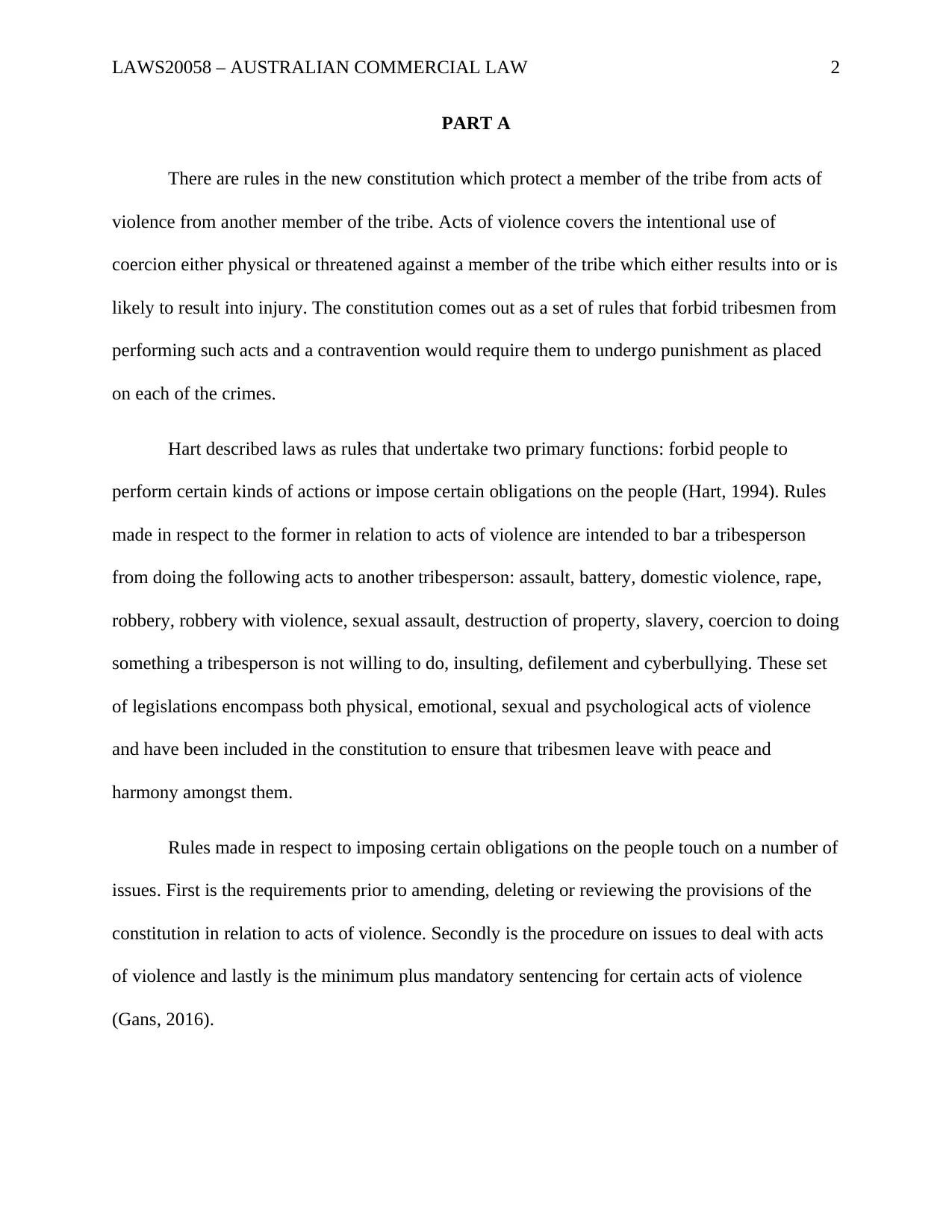
LAWS20058 – AUSTRALIAN COMMERCIAL LAW 2
PART A
There are rules in the new constitution which protect a member of the tribe from acts of
violence from another member of the tribe. Acts of violence covers the intentional use of
coercion either physical or threatened against a member of the tribe which either results into or is
likely to result into injury. The constitution comes out as a set of rules that forbid tribesmen from
performing such acts and a contravention would require them to undergo punishment as placed
on each of the crimes.
Hart described laws as rules that undertake two primary functions: forbid people to
perform certain kinds of actions or impose certain obligations on the people (Hart, 1994). Rules
made in respect to the former in relation to acts of violence are intended to bar a tribesperson
from doing the following acts to another tribesperson: assault, battery, domestic violence, rape,
robbery, robbery with violence, sexual assault, destruction of property, slavery, coercion to doing
something a tribesperson is not willing to do, insulting, defilement and cyberbullying. These set
of legislations encompass both physical, emotional, sexual and psychological acts of violence
and have been included in the constitution to ensure that tribesmen leave with peace and
harmony amongst them.
Rules made in respect to imposing certain obligations on the people touch on a number of
issues. First is the requirements prior to amending, deleting or reviewing the provisions of the
constitution in relation to acts of violence. Secondly is the procedure on issues to deal with acts
of violence and lastly is the minimum plus mandatory sentencing for certain acts of violence
(Gans, 2016).
PART A
There are rules in the new constitution which protect a member of the tribe from acts of
violence from another member of the tribe. Acts of violence covers the intentional use of
coercion either physical or threatened against a member of the tribe which either results into or is
likely to result into injury. The constitution comes out as a set of rules that forbid tribesmen from
performing such acts and a contravention would require them to undergo punishment as placed
on each of the crimes.
Hart described laws as rules that undertake two primary functions: forbid people to
perform certain kinds of actions or impose certain obligations on the people (Hart, 1994). Rules
made in respect to the former in relation to acts of violence are intended to bar a tribesperson
from doing the following acts to another tribesperson: assault, battery, domestic violence, rape,
robbery, robbery with violence, sexual assault, destruction of property, slavery, coercion to doing
something a tribesperson is not willing to do, insulting, defilement and cyberbullying. These set
of legislations encompass both physical, emotional, sexual and psychological acts of violence
and have been included in the constitution to ensure that tribesmen leave with peace and
harmony amongst them.
Rules made in respect to imposing certain obligations on the people touch on a number of
issues. First is the requirements prior to amending, deleting or reviewing the provisions of the
constitution in relation to acts of violence. Secondly is the procedure on issues to deal with acts
of violence and lastly is the minimum plus mandatory sentencing for certain acts of violence
(Gans, 2016).
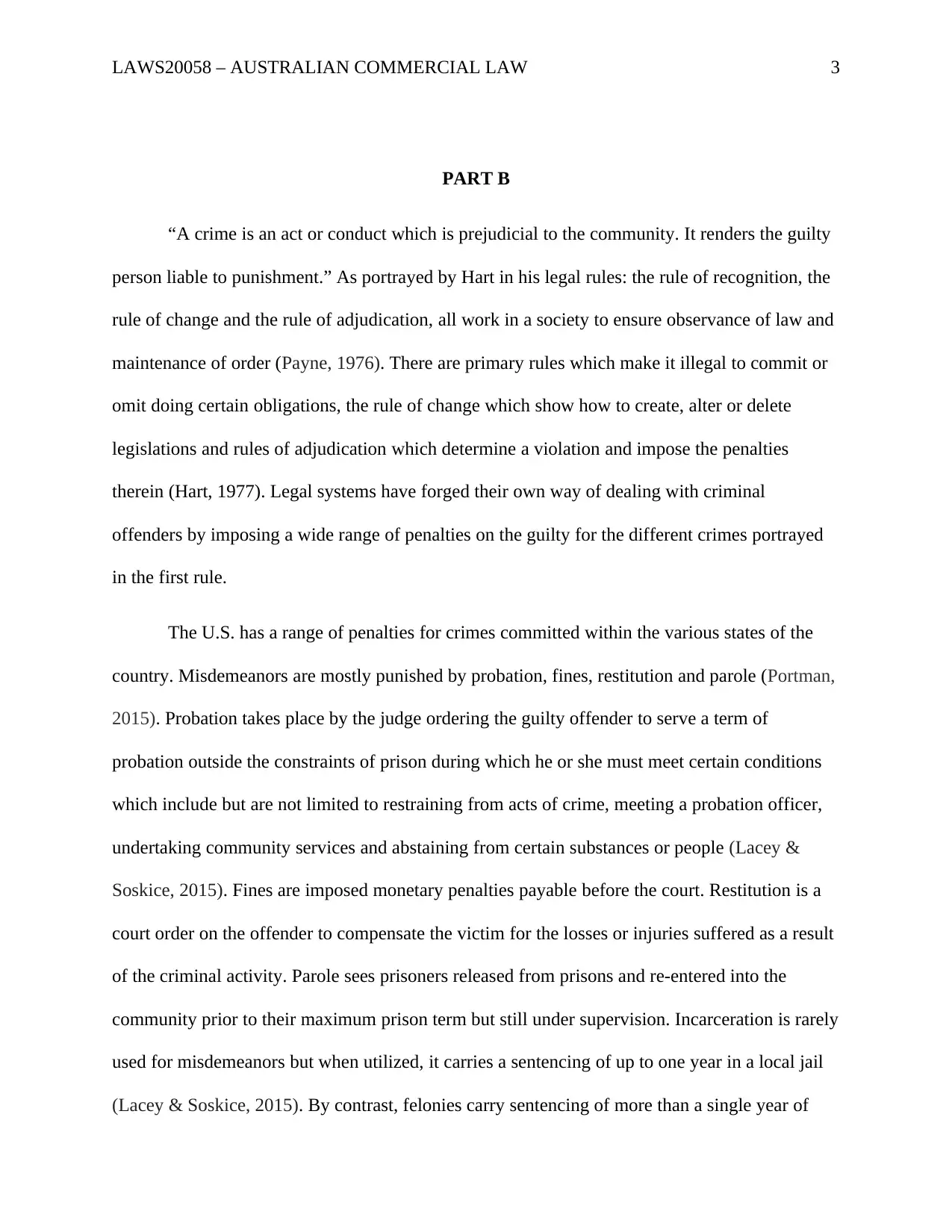
LAWS20058 – AUSTRALIAN COMMERCIAL LAW 3
PART B
“A crime is an act or conduct which is prejudicial to the community. It renders the guilty
person liable to punishment.” As portrayed by Hart in his legal rules: the rule of recognition, the
rule of change and the rule of adjudication, all work in a society to ensure observance of law and
maintenance of order (Payne, 1976). There are primary rules which make it illegal to commit or
omit doing certain obligations, the rule of change which show how to create, alter or delete
legislations and rules of adjudication which determine a violation and impose the penalties
therein (Hart, 1977). Legal systems have forged their own way of dealing with criminal
offenders by imposing a wide range of penalties on the guilty for the different crimes portrayed
in the first rule.
The U.S. has a range of penalties for crimes committed within the various states of the
country. Misdemeanors are mostly punished by probation, fines, restitution and parole (Portman,
2015). Probation takes place by the judge ordering the guilty offender to serve a term of
probation outside the constraints of prison during which he or she must meet certain conditions
which include but are not limited to restraining from acts of crime, meeting a probation officer,
undertaking community services and abstaining from certain substances or people (Lacey &
Soskice, 2015). Fines are imposed monetary penalties payable before the court. Restitution is a
court order on the offender to compensate the victim for the losses or injuries suffered as a result
of the criminal activity. Parole sees prisoners released from prisons and re-entered into the
community prior to their maximum prison term but still under supervision. Incarceration is rarely
used for misdemeanors but when utilized, it carries a sentencing of up to one year in a local jail
(Lacey & Soskice, 2015). By contrast, felonies carry sentencing of more than a single year of
PART B
“A crime is an act or conduct which is prejudicial to the community. It renders the guilty
person liable to punishment.” As portrayed by Hart in his legal rules: the rule of recognition, the
rule of change and the rule of adjudication, all work in a society to ensure observance of law and
maintenance of order (Payne, 1976). There are primary rules which make it illegal to commit or
omit doing certain obligations, the rule of change which show how to create, alter or delete
legislations and rules of adjudication which determine a violation and impose the penalties
therein (Hart, 1977). Legal systems have forged their own way of dealing with criminal
offenders by imposing a wide range of penalties on the guilty for the different crimes portrayed
in the first rule.
The U.S. has a range of penalties for crimes committed within the various states of the
country. Misdemeanors are mostly punished by probation, fines, restitution and parole (Portman,
2015). Probation takes place by the judge ordering the guilty offender to serve a term of
probation outside the constraints of prison during which he or she must meet certain conditions
which include but are not limited to restraining from acts of crime, meeting a probation officer,
undertaking community services and abstaining from certain substances or people (Lacey &
Soskice, 2015). Fines are imposed monetary penalties payable before the court. Restitution is a
court order on the offender to compensate the victim for the losses or injuries suffered as a result
of the criminal activity. Parole sees prisoners released from prisons and re-entered into the
community prior to their maximum prison term but still under supervision. Incarceration is rarely
used for misdemeanors but when utilized, it carries a sentencing of up to one year in a local jail
(Lacey & Soskice, 2015). By contrast, felonies carry sentencing of more than a single year of

LAWS20058 – AUSTRALIAN COMMERCIAL LAW 4
incarceration and the guilty are locked up in state prisons (Portman, 2015). The most heinous
crimes mostly see jail sentences which are served in federal prisons.
While Australia also deals with criminal offenders in an almost similar fashion, it is
important to note that fines are based on a system called penalty units. Such are calculated by
multiplying the value of one penalty unit by the number of penalty units set for that crime
(Queensland Government, 2018). There are also additional options for sentencing in Australia
which include rehabilitation, honing and boot camp.
PART C
Gumland Property Holdings Pty ltd. V Duffy Bros Fruit Market ( Campbelltown) Pty Ltd (2008)
234 CLR 237
Issue
i) Whether the defendant was liable for arrears of a sublease.
ii) Whether the plaintiff was justified to terminate a lease agreement on the basis of
failure to pay for a shortfall.
Rule
The rules applied by the court and relevant to the case were as follows:
i. The court will warn itself from disturbing an express provision of a lease agreement
that deems an intermediate or innominate term essential.
ii. Where a lessee commits a breach of an essential term in a lease agreement or
repudiates the lease, the lessor is at liberty to not only terminate the lease and be
entitled to arrears of rent in the process, but also recover damages for plausible and
possible future alleged losses.
Application
incarceration and the guilty are locked up in state prisons (Portman, 2015). The most heinous
crimes mostly see jail sentences which are served in federal prisons.
While Australia also deals with criminal offenders in an almost similar fashion, it is
important to note that fines are based on a system called penalty units. Such are calculated by
multiplying the value of one penalty unit by the number of penalty units set for that crime
(Queensland Government, 2018). There are also additional options for sentencing in Australia
which include rehabilitation, honing and boot camp.
PART C
Gumland Property Holdings Pty ltd. V Duffy Bros Fruit Market ( Campbelltown) Pty Ltd (2008)
234 CLR 237
Issue
i) Whether the defendant was liable for arrears of a sublease.
ii) Whether the plaintiff was justified to terminate a lease agreement on the basis of
failure to pay for a shortfall.
Rule
The rules applied by the court and relevant to the case were as follows:
i. The court will warn itself from disturbing an express provision of a lease agreement
that deems an intermediate or innominate term essential.
ii. Where a lessee commits a breach of an essential term in a lease agreement or
repudiates the lease, the lessor is at liberty to not only terminate the lease and be
entitled to arrears of rent in the process, but also recover damages for plausible and
possible future alleged losses.
Application
Secure Best Marks with AI Grader
Need help grading? Try our AI Grader for instant feedback on your assignments.
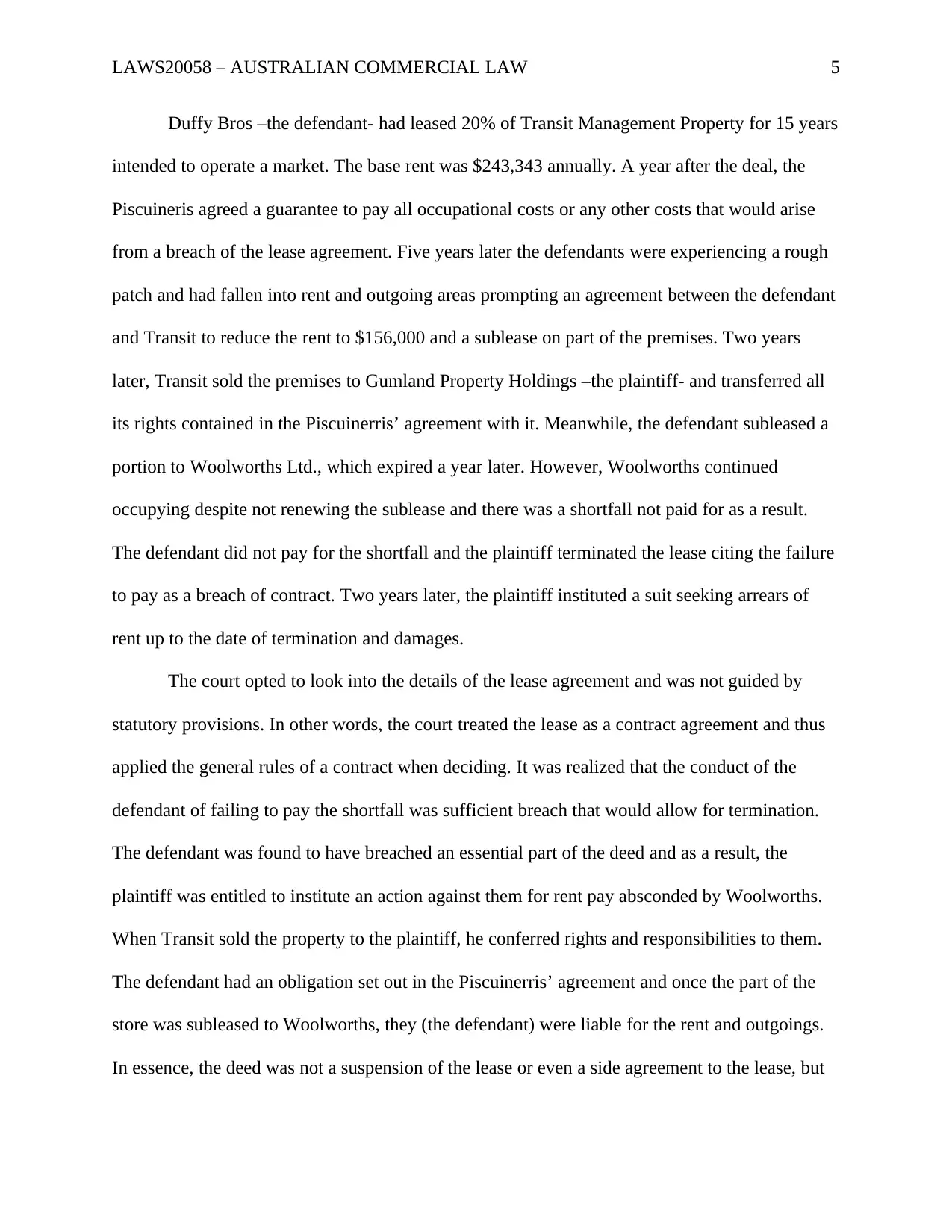
LAWS20058 – AUSTRALIAN COMMERCIAL LAW 5
Duffy Bros –the defendant- had leased 20% of Transit Management Property for 15 years
intended to operate a market. The base rent was $243,343 annually. A year after the deal, the
Piscuineris agreed a guarantee to pay all occupational costs or any other costs that would arise
from a breach of the lease agreement. Five years later the defendants were experiencing a rough
patch and had fallen into rent and outgoing areas prompting an agreement between the defendant
and Transit to reduce the rent to $156,000 and a sublease on part of the premises. Two years
later, Transit sold the premises to Gumland Property Holdings –the plaintiff- and transferred all
its rights contained in the Piscuinerris’ agreement with it. Meanwhile, the defendant subleased a
portion to Woolworths Ltd., which expired a year later. However, Woolworths continued
occupying despite not renewing the sublease and there was a shortfall not paid for as a result.
The defendant did not pay for the shortfall and the plaintiff terminated the lease citing the failure
to pay as a breach of contract. Two years later, the plaintiff instituted a suit seeking arrears of
rent up to the date of termination and damages.
The court opted to look into the details of the lease agreement and was not guided by
statutory provisions. In other words, the court treated the lease as a contract agreement and thus
applied the general rules of a contract when deciding. It was realized that the conduct of the
defendant of failing to pay the shortfall was sufficient breach that would allow for termination.
The defendant was found to have breached an essential part of the deed and as a result, the
plaintiff was entitled to institute an action against them for rent pay absconded by Woolworths.
When Transit sold the property to the plaintiff, he conferred rights and responsibilities to them.
The defendant had an obligation set out in the Piscuinerris’ agreement and once the part of the
store was subleased to Woolworths, they (the defendant) were liable for the rent and outgoings.
In essence, the deed was not a suspension of the lease or even a side agreement to the lease, but
Duffy Bros –the defendant- had leased 20% of Transit Management Property for 15 years
intended to operate a market. The base rent was $243,343 annually. A year after the deal, the
Piscuineris agreed a guarantee to pay all occupational costs or any other costs that would arise
from a breach of the lease agreement. Five years later the defendants were experiencing a rough
patch and had fallen into rent and outgoing areas prompting an agreement between the defendant
and Transit to reduce the rent to $156,000 and a sublease on part of the premises. Two years
later, Transit sold the premises to Gumland Property Holdings –the plaintiff- and transferred all
its rights contained in the Piscuinerris’ agreement with it. Meanwhile, the defendant subleased a
portion to Woolworths Ltd., which expired a year later. However, Woolworths continued
occupying despite not renewing the sublease and there was a shortfall not paid for as a result.
The defendant did not pay for the shortfall and the plaintiff terminated the lease citing the failure
to pay as a breach of contract. Two years later, the plaintiff instituted a suit seeking arrears of
rent up to the date of termination and damages.
The court opted to look into the details of the lease agreement and was not guided by
statutory provisions. In other words, the court treated the lease as a contract agreement and thus
applied the general rules of a contract when deciding. It was realized that the conduct of the
defendant of failing to pay the shortfall was sufficient breach that would allow for termination.
The defendant was found to have breached an essential part of the deed and as a result, the
plaintiff was entitled to institute an action against them for rent pay absconded by Woolworths.
When Transit sold the property to the plaintiff, he conferred rights and responsibilities to them.
The defendant had an obligation set out in the Piscuinerris’ agreement and once the part of the
store was subleased to Woolworths, they (the defendant) were liable for the rent and outgoings.
In essence, the deed was not a suspension of the lease or even a side agreement to the lease, but
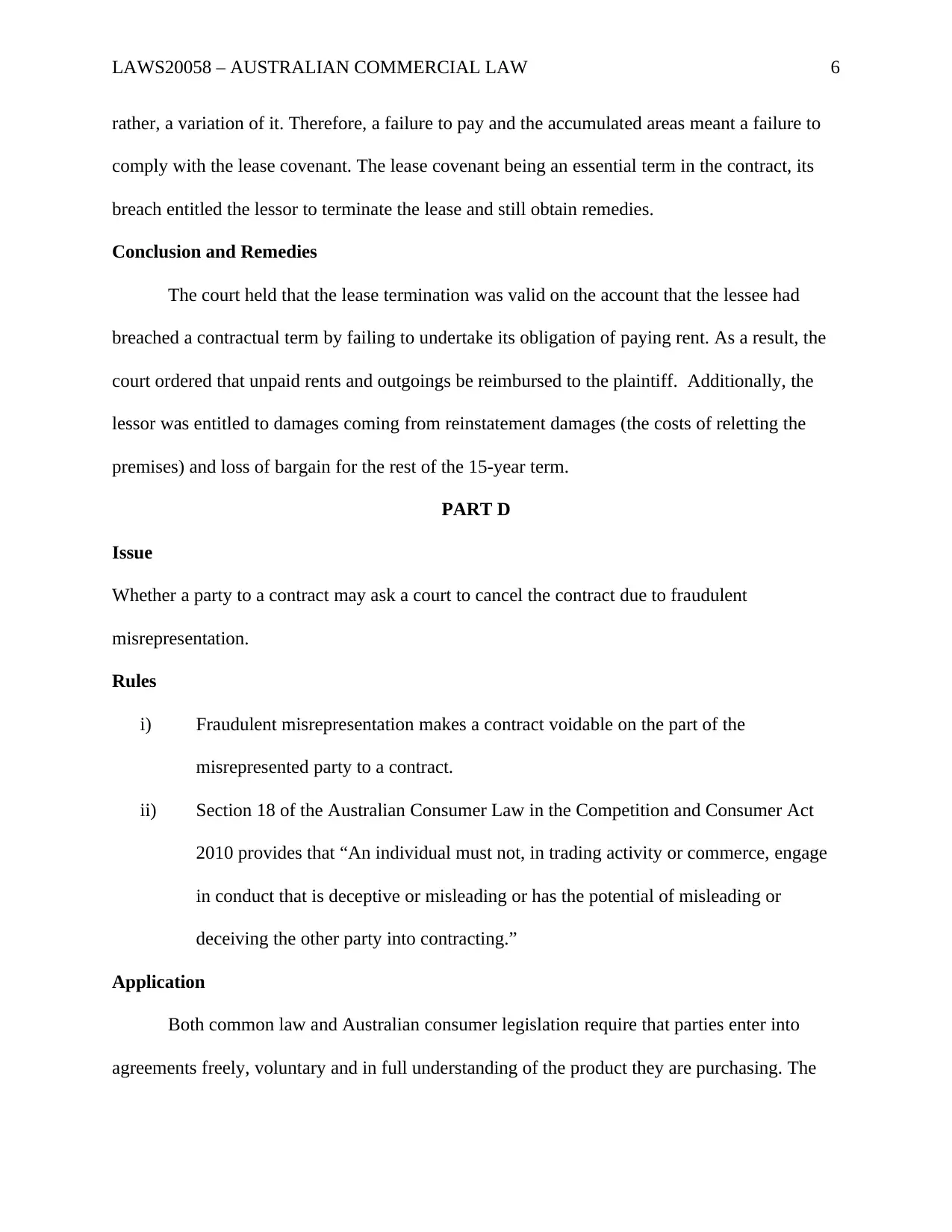
LAWS20058 – AUSTRALIAN COMMERCIAL LAW 6
rather, a variation of it. Therefore, a failure to pay and the accumulated areas meant a failure to
comply with the lease covenant. The lease covenant being an essential term in the contract, its
breach entitled the lessor to terminate the lease and still obtain remedies.
Conclusion and Remedies
The court held that the lease termination was valid on the account that the lessee had
breached a contractual term by failing to undertake its obligation of paying rent. As a result, the
court ordered that unpaid rents and outgoings be reimbursed to the plaintiff. Additionally, the
lessor was entitled to damages coming from reinstatement damages (the costs of reletting the
premises) and loss of bargain for the rest of the 15-year term.
PART D
Issue
Whether a party to a contract may ask a court to cancel the contract due to fraudulent
misrepresentation.
Rules
i) Fraudulent misrepresentation makes a contract voidable on the part of the
misrepresented party to a contract.
ii) Section 18 of the Australian Consumer Law in the Competition and Consumer Act
2010 provides that “An individual must not, in trading activity or commerce, engage
in conduct that is deceptive or misleading or has the potential of misleading or
deceiving the other party into contracting.”
Application
Both common law and Australian consumer legislation require that parties enter into
agreements freely, voluntary and in full understanding of the product they are purchasing. The
rather, a variation of it. Therefore, a failure to pay and the accumulated areas meant a failure to
comply with the lease covenant. The lease covenant being an essential term in the contract, its
breach entitled the lessor to terminate the lease and still obtain remedies.
Conclusion and Remedies
The court held that the lease termination was valid on the account that the lessee had
breached a contractual term by failing to undertake its obligation of paying rent. As a result, the
court ordered that unpaid rents and outgoings be reimbursed to the plaintiff. Additionally, the
lessor was entitled to damages coming from reinstatement damages (the costs of reletting the
premises) and loss of bargain for the rest of the 15-year term.
PART D
Issue
Whether a party to a contract may ask a court to cancel the contract due to fraudulent
misrepresentation.
Rules
i) Fraudulent misrepresentation makes a contract voidable on the part of the
misrepresented party to a contract.
ii) Section 18 of the Australian Consumer Law in the Competition and Consumer Act
2010 provides that “An individual must not, in trading activity or commerce, engage
in conduct that is deceptive or misleading or has the potential of misleading or
deceiving the other party into contracting.”
Application
Both common law and Australian consumer legislation require that parties enter into
agreements freely, voluntary and in full understanding of the product they are purchasing. The
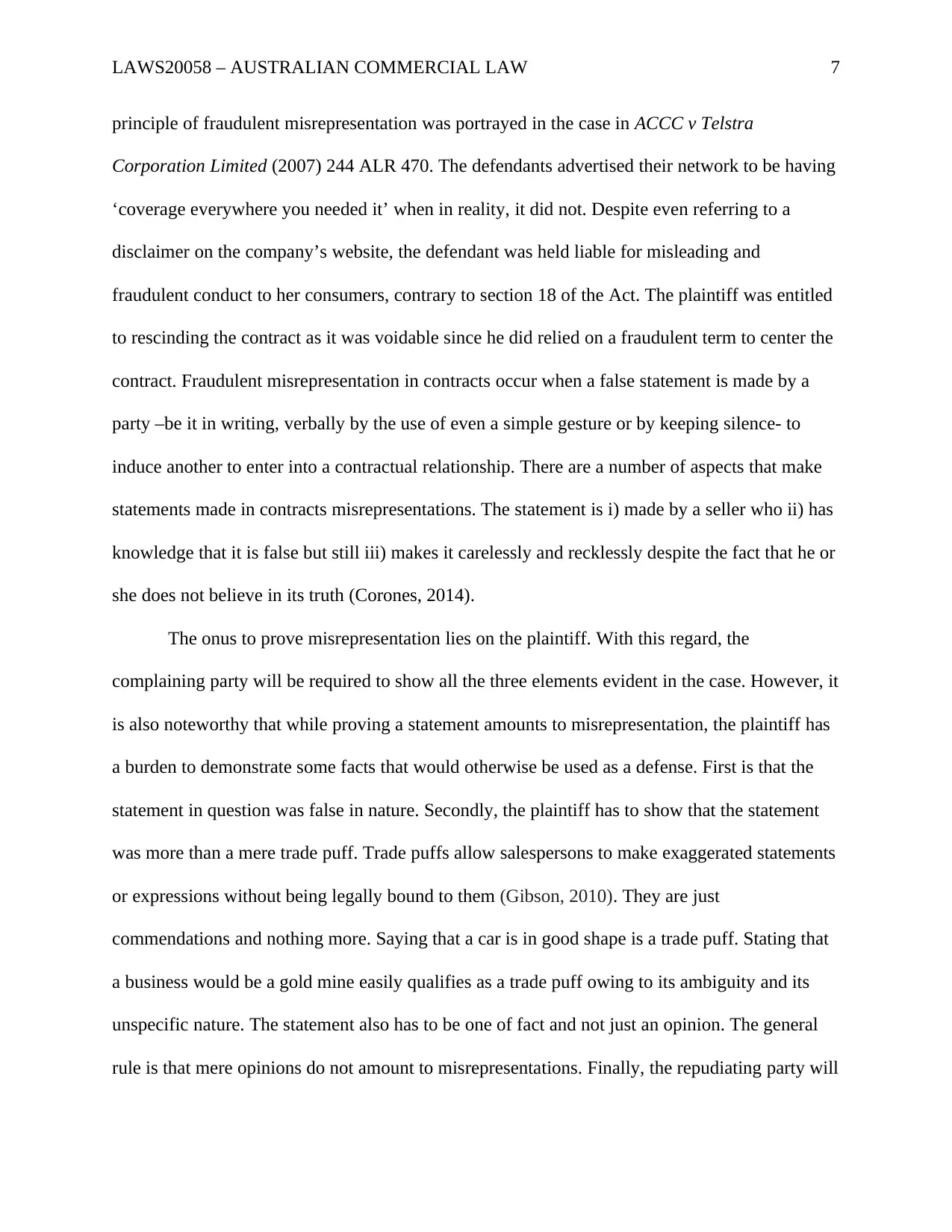
LAWS20058 – AUSTRALIAN COMMERCIAL LAW 7
principle of fraudulent misrepresentation was portrayed in the case in ACCC v Telstra
Corporation Limited (2007) 244 ALR 470. The defendants advertised their network to be having
‘coverage everywhere you needed it’ when in reality, it did not. Despite even referring to a
disclaimer on the company’s website, the defendant was held liable for misleading and
fraudulent conduct to her consumers, contrary to section 18 of the Act. The plaintiff was entitled
to rescinding the contract as it was voidable since he did relied on a fraudulent term to center the
contract. Fraudulent misrepresentation in contracts occur when a false statement is made by a
party –be it in writing, verbally by the use of even a simple gesture or by keeping silence- to
induce another to enter into a contractual relationship. There are a number of aspects that make
statements made in contracts misrepresentations. The statement is i) made by a seller who ii) has
knowledge that it is false but still iii) makes it carelessly and recklessly despite the fact that he or
she does not believe in its truth (Corones, 2014).
The onus to prove misrepresentation lies on the plaintiff. With this regard, the
complaining party will be required to show all the three elements evident in the case. However, it
is also noteworthy that while proving a statement amounts to misrepresentation, the plaintiff has
a burden to demonstrate some facts that would otherwise be used as a defense. First is that the
statement in question was false in nature. Secondly, the plaintiff has to show that the statement
was more than a mere trade puff. Trade puffs allow salespersons to make exaggerated statements
or expressions without being legally bound to them (Gibson, 2010). They are just
commendations and nothing more. Saying that a car is in good shape is a trade puff. Stating that
a business would be a gold mine easily qualifies as a trade puff owing to its ambiguity and its
unspecific nature. The statement also has to be one of fact and not just an opinion. The general
rule is that mere opinions do not amount to misrepresentations. Finally, the repudiating party will
principle of fraudulent misrepresentation was portrayed in the case in ACCC v Telstra
Corporation Limited (2007) 244 ALR 470. The defendants advertised their network to be having
‘coverage everywhere you needed it’ when in reality, it did not. Despite even referring to a
disclaimer on the company’s website, the defendant was held liable for misleading and
fraudulent conduct to her consumers, contrary to section 18 of the Act. The plaintiff was entitled
to rescinding the contract as it was voidable since he did relied on a fraudulent term to center the
contract. Fraudulent misrepresentation in contracts occur when a false statement is made by a
party –be it in writing, verbally by the use of even a simple gesture or by keeping silence- to
induce another to enter into a contractual relationship. There are a number of aspects that make
statements made in contracts misrepresentations. The statement is i) made by a seller who ii) has
knowledge that it is false but still iii) makes it carelessly and recklessly despite the fact that he or
she does not believe in its truth (Corones, 2014).
The onus to prove misrepresentation lies on the plaintiff. With this regard, the
complaining party will be required to show all the three elements evident in the case. However, it
is also noteworthy that while proving a statement amounts to misrepresentation, the plaintiff has
a burden to demonstrate some facts that would otherwise be used as a defense. First is that the
statement in question was false in nature. Secondly, the plaintiff has to show that the statement
was more than a mere trade puff. Trade puffs allow salespersons to make exaggerated statements
or expressions without being legally bound to them (Gibson, 2010). They are just
commendations and nothing more. Saying that a car is in good shape is a trade puff. Stating that
a business would be a gold mine easily qualifies as a trade puff owing to its ambiguity and its
unspecific nature. The statement also has to be one of fact and not just an opinion. The general
rule is that mere opinions do not amount to misrepresentations. Finally, the repudiating party will
Paraphrase This Document
Need a fresh take? Get an instant paraphrase of this document with our AI Paraphraser
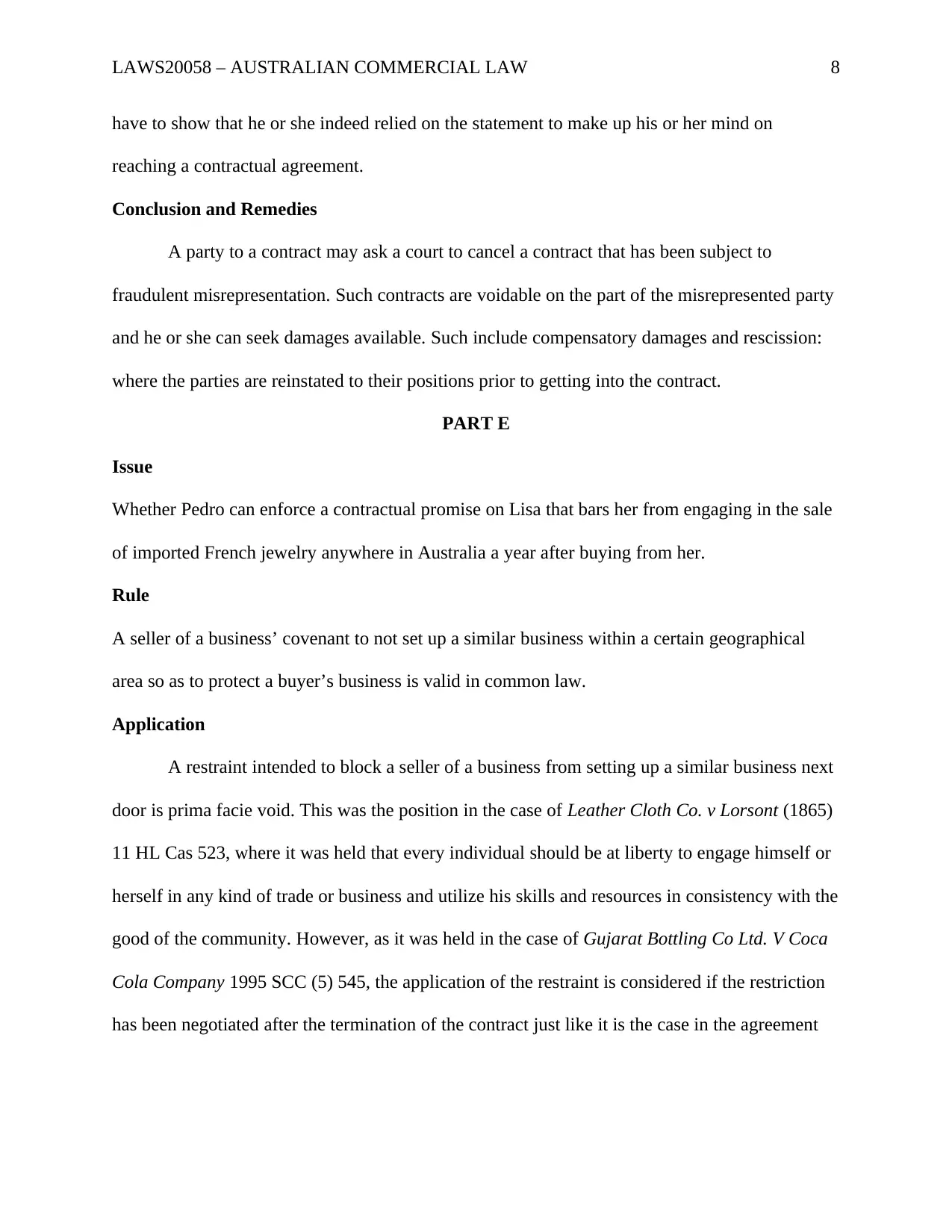
LAWS20058 – AUSTRALIAN COMMERCIAL LAW 8
have to show that he or she indeed relied on the statement to make up his or her mind on
reaching a contractual agreement.
Conclusion and Remedies
A party to a contract may ask a court to cancel a contract that has been subject to
fraudulent misrepresentation. Such contracts are voidable on the part of the misrepresented party
and he or she can seek damages available. Such include compensatory damages and rescission:
where the parties are reinstated to their positions prior to getting into the contract.
PART E
Issue
Whether Pedro can enforce a contractual promise on Lisa that bars her from engaging in the sale
of imported French jewelry anywhere in Australia a year after buying from her.
Rule
A seller of a business’ covenant to not set up a similar business within a certain geographical
area so as to protect a buyer’s business is valid in common law.
Application
A restraint intended to block a seller of a business from setting up a similar business next
door is prima facie void. This was the position in the case of Leather Cloth Co. v Lorsont (1865)
11 HL Cas 523, where it was held that every individual should be at liberty to engage himself or
herself in any kind of trade or business and utilize his skills and resources in consistency with the
good of the community. However, as it was held in the case of Gujarat Bottling Co Ltd. V Coca
Cola Company 1995 SCC (5) 545, the application of the restraint is considered if the restriction
has been negotiated after the termination of the contract just like it is the case in the agreement
have to show that he or she indeed relied on the statement to make up his or her mind on
reaching a contractual agreement.
Conclusion and Remedies
A party to a contract may ask a court to cancel a contract that has been subject to
fraudulent misrepresentation. Such contracts are voidable on the part of the misrepresented party
and he or she can seek damages available. Such include compensatory damages and rescission:
where the parties are reinstated to their positions prior to getting into the contract.
PART E
Issue
Whether Pedro can enforce a contractual promise on Lisa that bars her from engaging in the sale
of imported French jewelry anywhere in Australia a year after buying from her.
Rule
A seller of a business’ covenant to not set up a similar business within a certain geographical
area so as to protect a buyer’s business is valid in common law.
Application
A restraint intended to block a seller of a business from setting up a similar business next
door is prima facie void. This was the position in the case of Leather Cloth Co. v Lorsont (1865)
11 HL Cas 523, where it was held that every individual should be at liberty to engage himself or
herself in any kind of trade or business and utilize his skills and resources in consistency with the
good of the community. However, as it was held in the case of Gujarat Bottling Co Ltd. V Coca
Cola Company 1995 SCC (5) 545, the application of the restraint is considered if the restriction
has been negotiated after the termination of the contract just like it is the case in the agreement
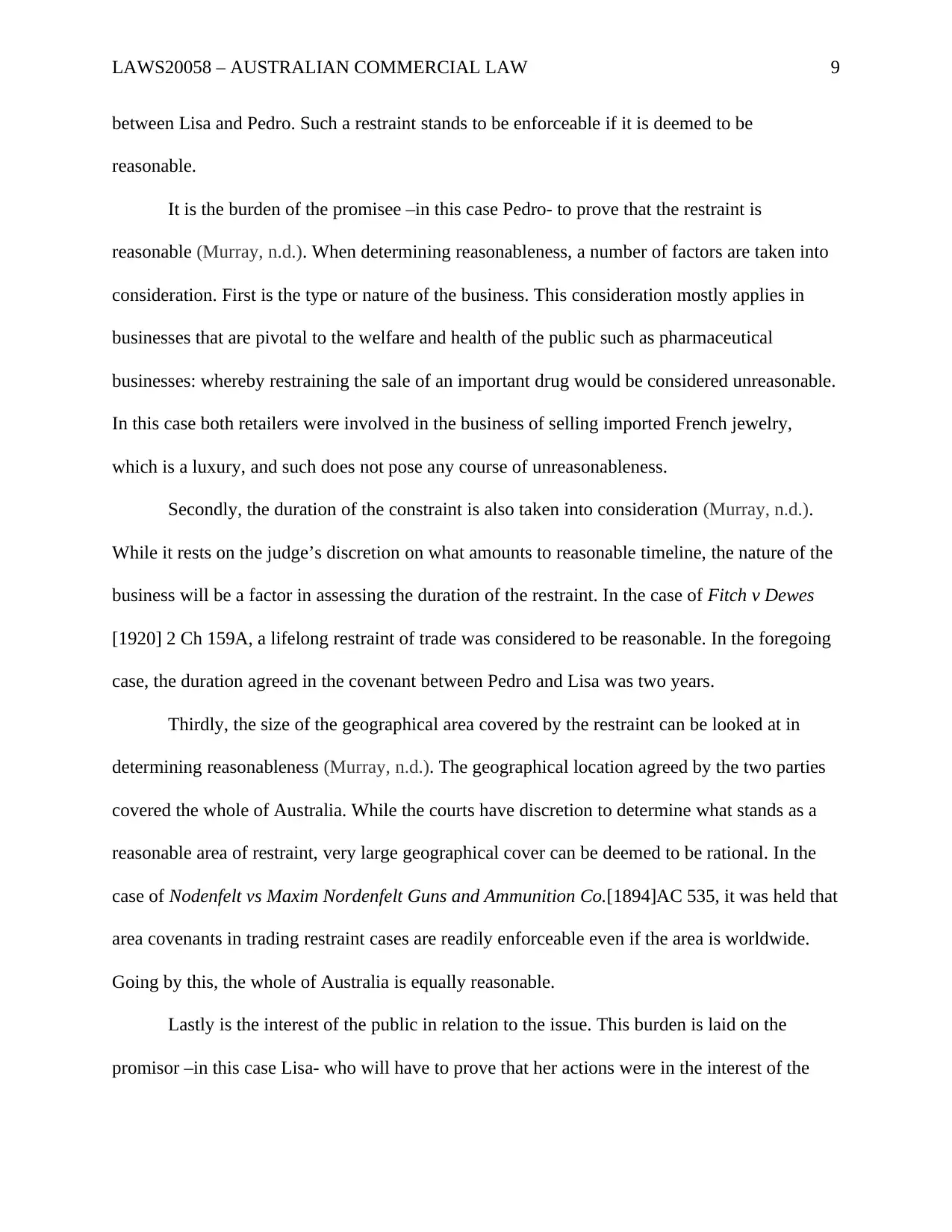
LAWS20058 – AUSTRALIAN COMMERCIAL LAW 9
between Lisa and Pedro. Such a restraint stands to be enforceable if it is deemed to be
reasonable.
It is the burden of the promisee –in this case Pedro- to prove that the restraint is
reasonable (Murray, n.d.). When determining reasonableness, a number of factors are taken into
consideration. First is the type or nature of the business. This consideration mostly applies in
businesses that are pivotal to the welfare and health of the public such as pharmaceutical
businesses: whereby restraining the sale of an important drug would be considered unreasonable.
In this case both retailers were involved in the business of selling imported French jewelry,
which is a luxury, and such does not pose any course of unreasonableness.
Secondly, the duration of the constraint is also taken into consideration (Murray, n.d.).
While it rests on the judge’s discretion on what amounts to reasonable timeline, the nature of the
business will be a factor in assessing the duration of the restraint. In the case of Fitch v Dewes
[1920] 2 Ch 159A, a lifelong restraint of trade was considered to be reasonable. In the foregoing
case, the duration agreed in the covenant between Pedro and Lisa was two years.
Thirdly, the size of the geographical area covered by the restraint can be looked at in
determining reasonableness (Murray, n.d.). The geographical location agreed by the two parties
covered the whole of Australia. While the courts have discretion to determine what stands as a
reasonable area of restraint, very large geographical cover can be deemed to be rational. In the
case of Nodenfelt vs Maxim Nordenfelt Guns and Ammunition Co.[1894]AC 535, it was held that
area covenants in trading restraint cases are readily enforceable even if the area is worldwide.
Going by this, the whole of Australia is equally reasonable.
Lastly is the interest of the public in relation to the issue. This burden is laid on the
promisor –in this case Lisa- who will have to prove that her actions were in the interest of the
between Lisa and Pedro. Such a restraint stands to be enforceable if it is deemed to be
reasonable.
It is the burden of the promisee –in this case Pedro- to prove that the restraint is
reasonable (Murray, n.d.). When determining reasonableness, a number of factors are taken into
consideration. First is the type or nature of the business. This consideration mostly applies in
businesses that are pivotal to the welfare and health of the public such as pharmaceutical
businesses: whereby restraining the sale of an important drug would be considered unreasonable.
In this case both retailers were involved in the business of selling imported French jewelry,
which is a luxury, and such does not pose any course of unreasonableness.
Secondly, the duration of the constraint is also taken into consideration (Murray, n.d.).
While it rests on the judge’s discretion on what amounts to reasonable timeline, the nature of the
business will be a factor in assessing the duration of the restraint. In the case of Fitch v Dewes
[1920] 2 Ch 159A, a lifelong restraint of trade was considered to be reasonable. In the foregoing
case, the duration agreed in the covenant between Pedro and Lisa was two years.
Thirdly, the size of the geographical area covered by the restraint can be looked at in
determining reasonableness (Murray, n.d.). The geographical location agreed by the two parties
covered the whole of Australia. While the courts have discretion to determine what stands as a
reasonable area of restraint, very large geographical cover can be deemed to be rational. In the
case of Nodenfelt vs Maxim Nordenfelt Guns and Ammunition Co.[1894]AC 535, it was held that
area covenants in trading restraint cases are readily enforceable even if the area is worldwide.
Going by this, the whole of Australia is equally reasonable.
Lastly is the interest of the public in relation to the issue. This burden is laid on the
promisor –in this case Lisa- who will have to prove that her actions were in the interest of the
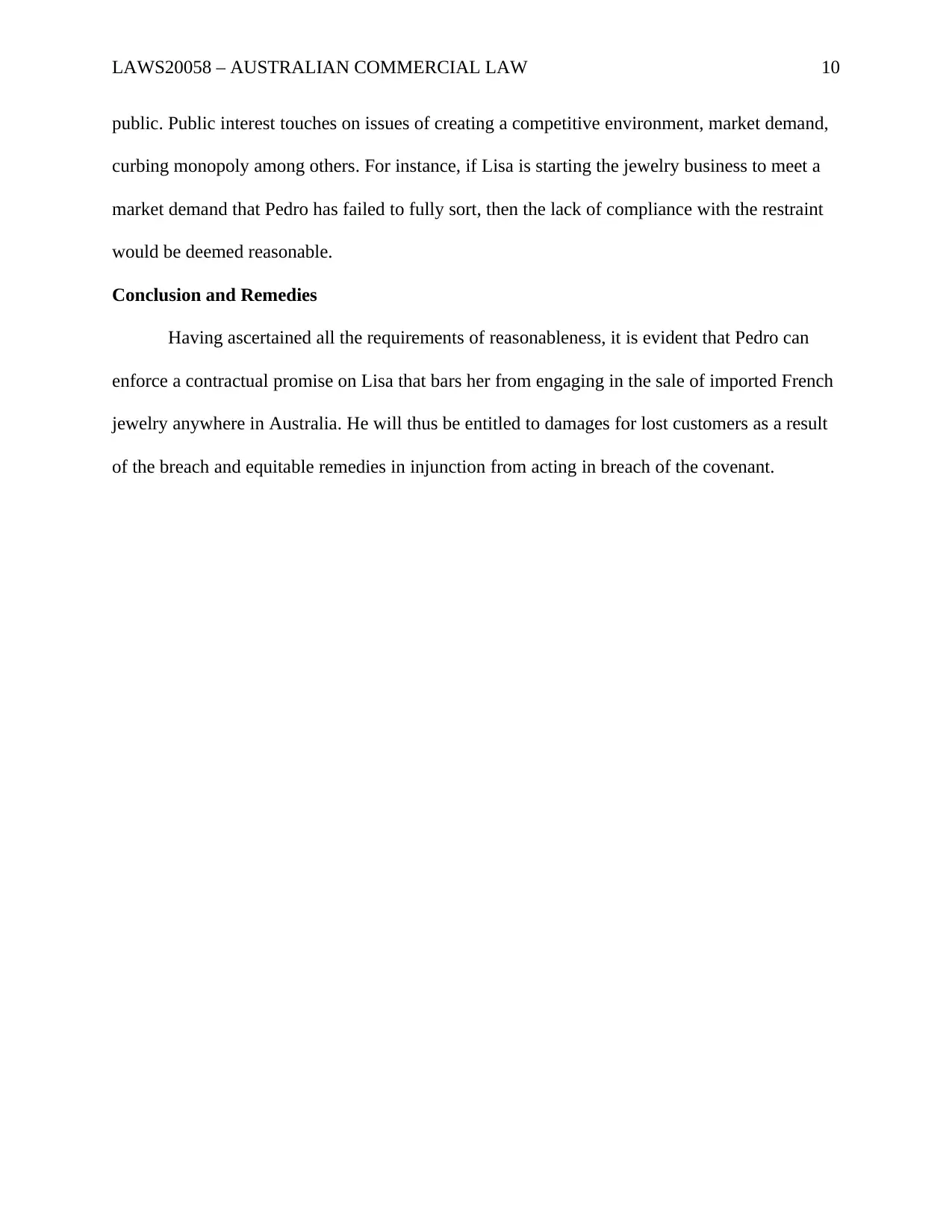
LAWS20058 – AUSTRALIAN COMMERCIAL LAW 10
public. Public interest touches on issues of creating a competitive environment, market demand,
curbing monopoly among others. For instance, if Lisa is starting the jewelry business to meet a
market demand that Pedro has failed to fully sort, then the lack of compliance with the restraint
would be deemed reasonable.
Conclusion and Remedies
Having ascertained all the requirements of reasonableness, it is evident that Pedro can
enforce a contractual promise on Lisa that bars her from engaging in the sale of imported French
jewelry anywhere in Australia. He will thus be entitled to damages for lost customers as a result
of the breach and equitable remedies in injunction from acting in breach of the covenant.
public. Public interest touches on issues of creating a competitive environment, market demand,
curbing monopoly among others. For instance, if Lisa is starting the jewelry business to meet a
market demand that Pedro has failed to fully sort, then the lack of compliance with the restraint
would be deemed reasonable.
Conclusion and Remedies
Having ascertained all the requirements of reasonableness, it is evident that Pedro can
enforce a contractual promise on Lisa that bars her from engaging in the sale of imported French
jewelry anywhere in Australia. He will thus be entitled to damages for lost customers as a result
of the breach and equitable remedies in injunction from acting in breach of the covenant.
Secure Best Marks with AI Grader
Need help grading? Try our AI Grader for instant feedback on your assignments.
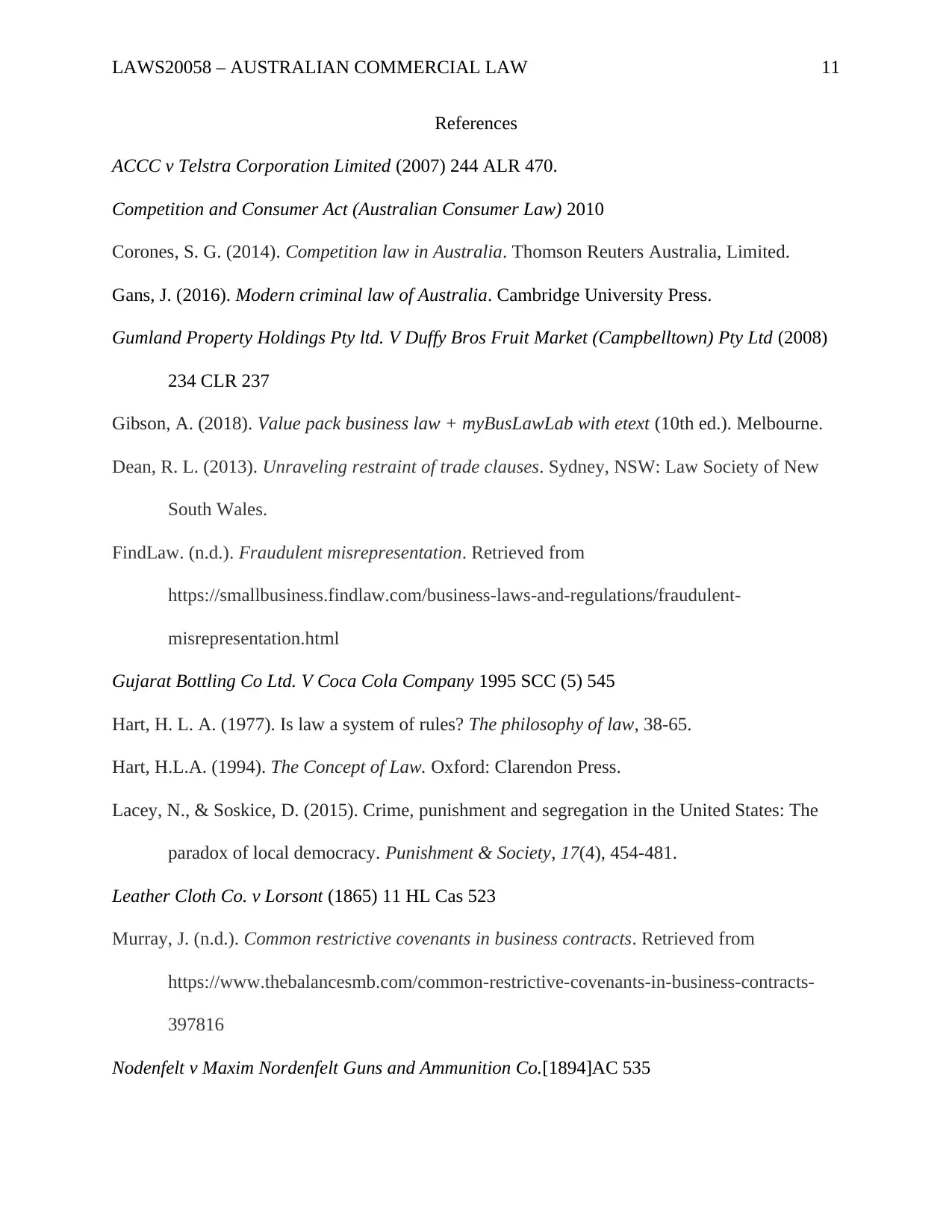
LAWS20058 – AUSTRALIAN COMMERCIAL LAW 11
References
ACCC v Telstra Corporation Limited (2007) 244 ALR 470.
Competition and Consumer Act (Australian Consumer Law) 2010
Corones, S. G. (2014). Competition law in Australia. Thomson Reuters Australia, Limited.
Gans, J. (2016). Modern criminal law of Australia. Cambridge University Press.
Gumland Property Holdings Pty ltd. V Duffy Bros Fruit Market (Campbelltown) Pty Ltd (2008)
234 CLR 237
Gibson, A. (2018). Value pack business law + myBusLawLab with etext (10th ed.). Melbourne.
Dean, R. L. (2013). Unraveling restraint of trade clauses. Sydney, NSW: Law Society of New
South Wales.
FindLaw. (n.d.). Fraudulent misrepresentation. Retrieved from
https://smallbusiness.findlaw.com/business-laws-and-regulations/fraudulent-
misrepresentation.html
Gujarat Bottling Co Ltd. V Coca Cola Company 1995 SCC (5) 545
Hart, H. L. A. (1977). Is law a system of rules? The philosophy of law, 38-65.
Hart, H.L.A. (1994). The Concept of Law. Oxford: Clarendon Press.
Lacey, N., & Soskice, D. (2015). Crime, punishment and segregation in the United States: The
paradox of local democracy. Punishment & Society, 17(4), 454-481.
Leather Cloth Co. v Lorsont (1865) 11 HL Cas 523
Murray, J. (n.d.). Common restrictive covenants in business contracts. Retrieved from
https://www.thebalancesmb.com/common-restrictive-covenants-in-business-contracts-
397816
Nodenfelt v Maxim Nordenfelt Guns and Ammunition Co.[1894]AC 535
References
ACCC v Telstra Corporation Limited (2007) 244 ALR 470.
Competition and Consumer Act (Australian Consumer Law) 2010
Corones, S. G. (2014). Competition law in Australia. Thomson Reuters Australia, Limited.
Gans, J. (2016). Modern criminal law of Australia. Cambridge University Press.
Gumland Property Holdings Pty ltd. V Duffy Bros Fruit Market (Campbelltown) Pty Ltd (2008)
234 CLR 237
Gibson, A. (2018). Value pack business law + myBusLawLab with etext (10th ed.). Melbourne.
Dean, R. L. (2013). Unraveling restraint of trade clauses. Sydney, NSW: Law Society of New
South Wales.
FindLaw. (n.d.). Fraudulent misrepresentation. Retrieved from
https://smallbusiness.findlaw.com/business-laws-and-regulations/fraudulent-
misrepresentation.html
Gujarat Bottling Co Ltd. V Coca Cola Company 1995 SCC (5) 545
Hart, H. L. A. (1977). Is law a system of rules? The philosophy of law, 38-65.
Hart, H.L.A. (1994). The Concept of Law. Oxford: Clarendon Press.
Lacey, N., & Soskice, D. (2015). Crime, punishment and segregation in the United States: The
paradox of local democracy. Punishment & Society, 17(4), 454-481.
Leather Cloth Co. v Lorsont (1865) 11 HL Cas 523
Murray, J. (n.d.). Common restrictive covenants in business contracts. Retrieved from
https://www.thebalancesmb.com/common-restrictive-covenants-in-business-contracts-
397816
Nodenfelt v Maxim Nordenfelt Guns and Ammunition Co.[1894]AC 535
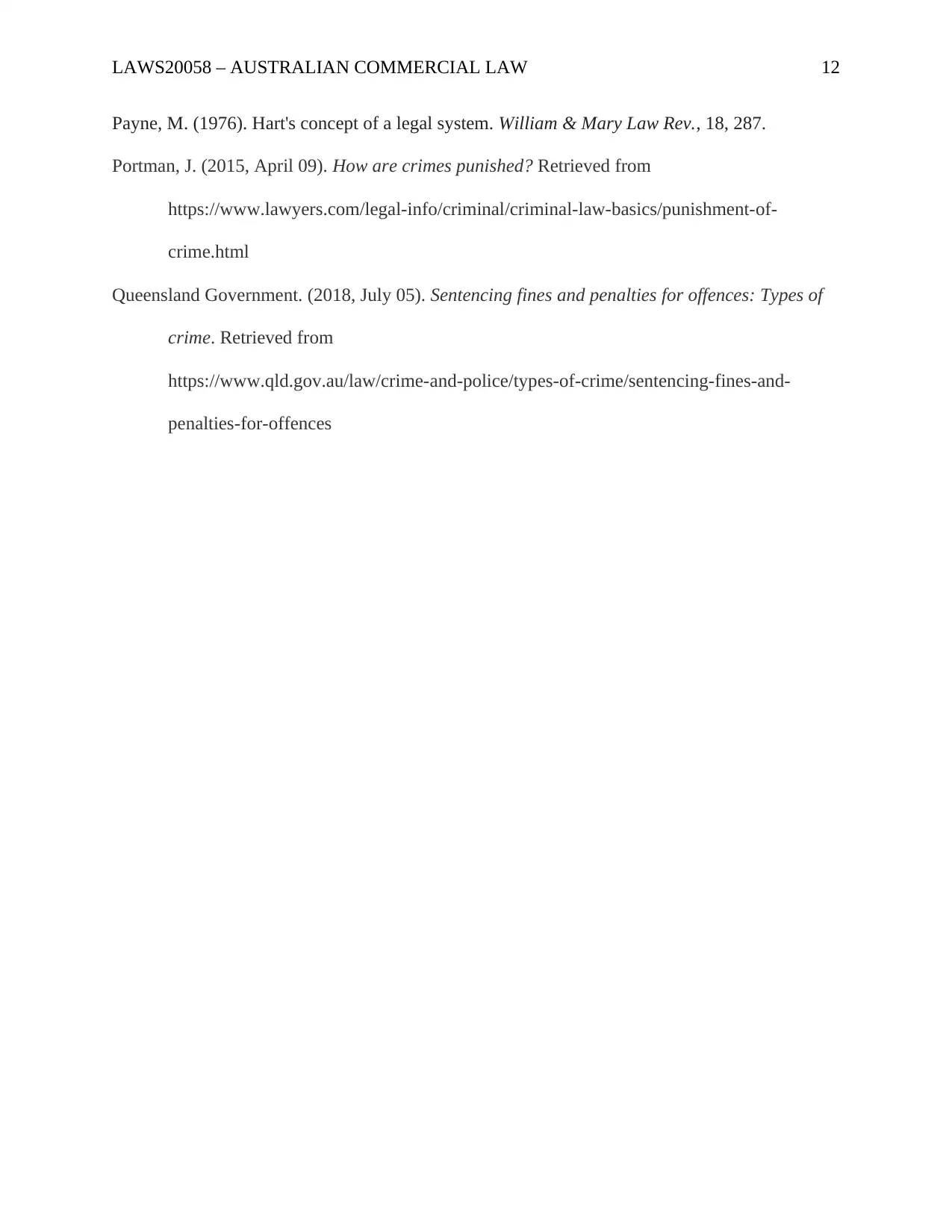
LAWS20058 – AUSTRALIAN COMMERCIAL LAW 12
Payne, M. (1976). Hart's concept of a legal system. William & Mary Law Rev., 18, 287.
Portman, J. (2015, April 09). How are crimes punished? Retrieved from
https://www.lawyers.com/legal-info/criminal/criminal-law-basics/punishment-of-
crime.html
Queensland Government. (2018, July 05). Sentencing fines and penalties for offences: Types of
crime. Retrieved from
https://www.qld.gov.au/law/crime-and-police/types-of-crime/sentencing-fines-and-
penalties-for-offences
Payne, M. (1976). Hart's concept of a legal system. William & Mary Law Rev., 18, 287.
Portman, J. (2015, April 09). How are crimes punished? Retrieved from
https://www.lawyers.com/legal-info/criminal/criminal-law-basics/punishment-of-
crime.html
Queensland Government. (2018, July 05). Sentencing fines and penalties for offences: Types of
crime. Retrieved from
https://www.qld.gov.au/law/crime-and-police/types-of-crime/sentencing-fines-and-
penalties-for-offences
1 out of 12
Related Documents
Your All-in-One AI-Powered Toolkit for Academic Success.
+13062052269
info@desklib.com
Available 24*7 on WhatsApp / Email
![[object Object]](/_next/static/media/star-bottom.7253800d.svg)
Unlock your academic potential
© 2024 | Zucol Services PVT LTD | All rights reserved.




